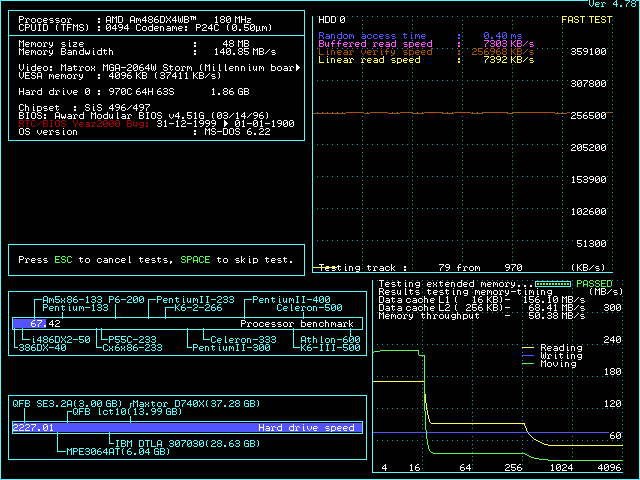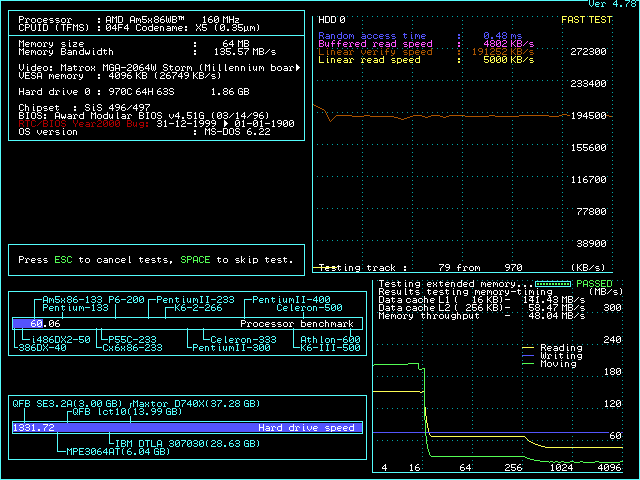Reply 380 of 2436, by feipoa
- Rank
- l33t++
Perhaps you found a method to find the chips with a faster response time.
Plan your life wisely, you'll be dead before you know it.
Perhaps you found a method to find the chips with a faster response time.
Plan your life wisely, you'll be dead before you know it.
Do you know if Lucky Star LS486E Rev. C2 or Rev. F have a funcitonal floppy controller/drive with a 66 MHz FSB?
Plan your life wisely, you'll be dead before you know it.
feipoa wrote on 2021-07-25, 15:34:Do you know if Lucky Star LS486E Rev. C2 or Rev. F have a funcitonal floppy controller/drive with a 66 MHz FSB?
Sorry if this has been addressed - but did you make sure to set the ISA clock to the fixed 7.whatever MHz setting in the advanced chipset settings?
I don't have a 486 CPU that will post at 66MHz FSB so I can't help testing
Yes, I had it setup that way.
Can check later if LS C2.
Here's the guy with the 66 MHz LS486E Rev. D. Re: The World's Fastest 486
He replaced the SRAM with 8 ns for TAG and 10 ns for data.
He compares edo vs. fpm on this board here: Re: The World's Fastest 486
Plan your life wisely, you'll be dead before you know it.
I also considered to improve on the l2 cache for LS D, but only after done sketching the 180mhz landscape - 4-5 more motherboards to go until then.
The information in his post simplifies the task a lot - it provides the required chip brands and models.
For 486 cpus the vrm mod is unnecessary.
But i doubt these modifications actually will improve on the hanging floppy controller.
User ph4nt0m has confirmed that the floppy does not work beyond 60 MHz, which is really unfortunate. I wonder if an ISA multi-I/O card can be convinced to work. Otherwise, LS-120 might be the only other alternative. He also said that the 1/2 PCI divisor is not reliable at 66 MHz, which I find surprising. I will have to play with this some, but I'm still working on my cars in the evenings these days.
EDIT: He also mentioned that 15 ns SRAM is not sufficient for this board at 66 MHz. Said the issue was resolved with the 8 ns TAG and 10 ns DATA, but perhaps the board is just SRAM picky? EDIT: ph4nt0m said via PM that 3-2-2-2 was fine with 15 ns SRAM. The faster SRAM allowed for 3-1-1-1.
Plan your life wisely, you'll be dead before you know it.
I can echo the sentiment about the PCI divisor. It's not reliable at 50MHz FSB either
What's the ISA divider? I have had i/o cards working at 12-13 Mhz, though you gotta try a few, some barf above 10. Didn't find one that did 15. ISA vid might kinda cope @15, but thats a bit academic when it leaves you nothing to boot off. Also NICs and Sound tend to screw up much over 10, you might find some that work at 11ish. 33/3 for instance. I had a system get good i/o performance on that, but I wanted it at 40 so had to settle for 40/4
Unicorn herding operations are proceeding, but all the totes of hens teeth and barrels of rocking horse poop give them plenty of hiding spots.
The board offers 1/3 and 1/4 ISA dividers as well as a fixed ISA clock option of 7.16MHz. We are using the latter
I also left my ISA clock fixed to 7.x MHz, so the ISA clock rate isn't the issue with the floppy drive.
Plan your life wisely, you'll be dead before you know it.
I can boot the LS D at 66mhz but yet to find out how stable it is.
Already splurged $$ for faster cache chips.
I was on the brink of doing it anyway to upgrade a flaky M919 cache module for tight wait states at 180 mhz.
Some fast 286 boards can push peripherals at 13MHz ++.
Seems to be fine for most ISA IDE controllers.
But yes, some ISA cards trip at these freqs.
@feipoa
Luckystar 486E rev.F = rev.B or something like that = an earlier version than C# and D.
I touched on it in this post.
Good board overall. Cannot remember ever trying on it 60 or more MHz base frequency.
I think i sold it for $50 last year (or was it last-last year ?).
Brief attempt to get C2 running at 66MHz didn't go well. It boots but hangs at post.
I think this can be overcome, but need to try it for real.
Somebody needs to produce DIP adapters for these 8 and 10ns cache chips...
"Will the highways on the internets become more few?" -Gee Dubya
V'Ger XT|Upgraded AT|Ultimate 386|Super VL/EISA 486|SMP VL/EISA Pentium
386/486 overclocking is 70%+ bottlenecked by l2 sram chips, so you have a point here.
I can make the pcb design but have no idea about Labs that can produce stuff in small quantities.
It is probably an online search away ...
There are guys around here who know the ways.
LuckyStar LS-486E revision C2 based on SiS 85C496, 85C497
--- Am5x86 at 180MHz (3x60)
Mandatory 4V to the CPU is required. Tried with multiple CPUs - the rule held true for all of them.
Default BIOS does not support EDO RAM. Tried revision D BIOS, but the system was more stable with the original BIOS and FPM memory. Didn't expect that.
The picture above shows 256Kb 15ns WinBond branded L2 cache chips, but complete stability was achieved with 12ns ISSI tag and a mixture of 15ns UMC and WinBond chips.
Tried 10ns ISSI 1024k ones as well. They didn't get recognized, whjch was expected, but wanted to check - just in case ...
Also, tried 128Kb 12ns ISSI chips - didn't make a noticeable difference in stability at lower wait states compared to the 15ns ones, so went with the bigger cache size.
Initial BIOS settings configuration:
L2 cache in WT mode - same or faster than WB, depends on which test you ask
CACHE WRITE CYCLES = 3 (up from 2)
DRAM CAS TO MA DELAY = 2 (up from 1)
DRAM SLOW REFRESH = DISABLED
The interactive DOS tests took these settings well, but Windows and the more sensitive computation tasks were unstable. Also, the maximum recognized amount of RAM was 48Mb, despite 64Mb installed.
Setting L2 CACHE/DRAM CYCLE WS = 3 (up from 2) fixed these issues for good at a small performance expense.
Promise UltraATA-100 or 133 PCI controllers are unreliable on this motherboard when FSB is set to 60/66MHz, regardless if bus divider is applied or not.
Used the on-bard IDE controller, which worked just fine.

Couple of interesting things to notice.
Great Doom score - easily the best at 180MHz from everything i have seen around so far, but at the cost of compromised system stability.
The board can be pushed quite a bit around, but i think revision D is the higher place overall, if we consider complete stability.
Still, some good "medals" awarded here.
--- Am5x86 at 160MHz (4x40)
All BIOS settings on max, except DRAM CAS TO MA DELAY = 2 (up from 1).
L2 cache in WT mode.
FPM RAM.

Pretty much the same as revision D.
--- Intel Overdrive P24T (POD100) at 100MHz (2.5x40)
---
while testing the motherboard i checked couple of mid 90ies, mostly period correct PCI video cards (pictures in the first page of this thread):
Cirrus Logic GD-5480
ET6000
S3 Virge/DX
Permedia 2
S3 Trio64V2/DX
Trident Providia 9685
Ark2000PV
While the board loves Matrox Millennium when running at 180MHz, at 160MHz Cirrus Logic GD-5480 came a bit stronger than the rest in Doom and Quake 1. But does not light up at 180MHz - too bad.
Et6000 did best in Wolf3D.
In general the differences were really minor.
---
As most late PCI/ISA motherboards - not the fastest clock-to-clock system out there, but pretty good at 160 and scales well to 180MHz.
pshipkov wrote on 2021-07-24, 04:32:@Feipoa
Pretty sure the BIOS chip is Winbond WB29EE011-15.
I use spare EEPROMs - safer and predictable, also, not destructive to the all important BIOS sticker. :}
Mine definitely isn't a 29EE011 - wouldn't erase/program. The auto detect function of my programmer guessed it was either:
AT27C010, AT27C010L, AT27LV010, AT27LV010A, or AT27BV010. I selected the first option, but it again would not erase/program. It is probably a one-time-programmable, or OTP EPROM. Cheapskates. To retain item value, I'm not removing the BIOS sticker.
Plan your life wisely, you'll be dead before you know it.
Getting an EEPROM on late 486 thru the socket 5 pentium boards was always hit and miss, then there's still the odd socket 7 that hasn't got one.
Unicorn herding operations are proceeding, but all the totes of hens teeth and barrels of rocking horse poop give them plenty of hiding spots.
BitWrangler wrote on 2021-07-31, 12:30:Getting an EEPROM on late 486 thru the socket 5 pentium boards was always hit and miss, then there's still the odd socket 7 that hasn't got one.
Usually PC Chips boards!
Plan your life wisely, you'll be dead before you know it.
pshipkov, did you find your LS-486E rev.D unable to save the CMOS year passed 1999 ? When I put in 2021, it reverts back to 1996. It will save if I input a year of 1999 or earlier.
Also, I have performed the PS/2 mouse mod, however I am currently unable to get the PS/2 mouse recognised. I've checked all the connections and am using an AMIKEY-2. Have you done this mod?
Plan your life wisely, you'll be dead before you know it.